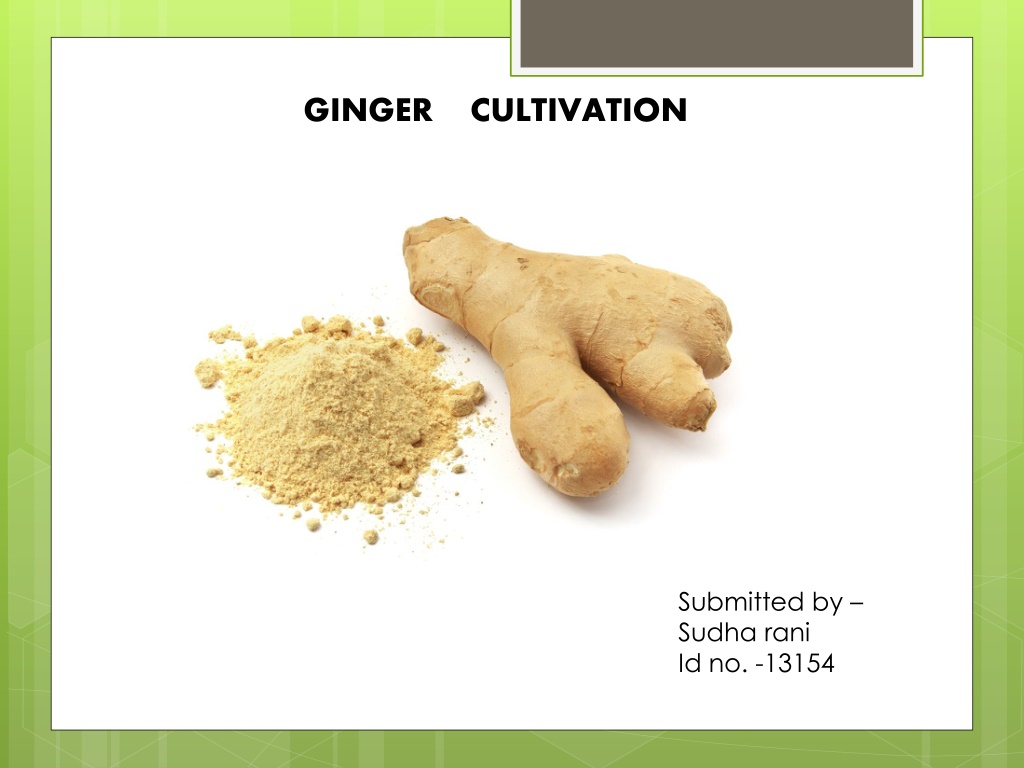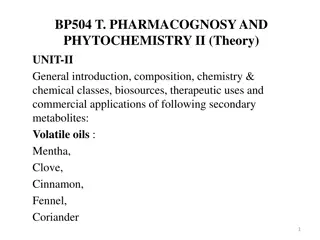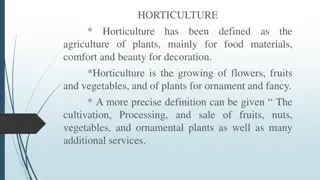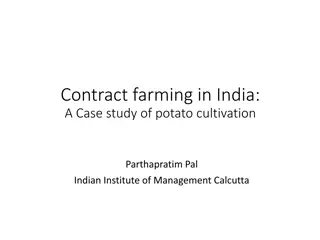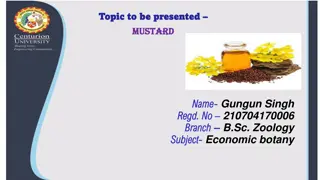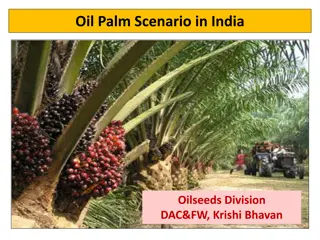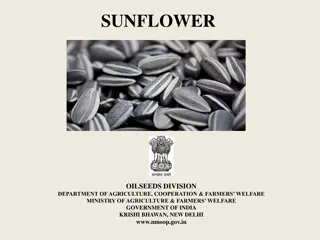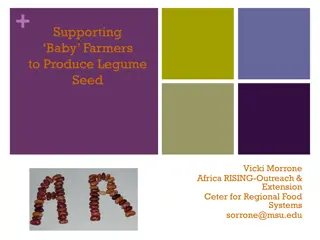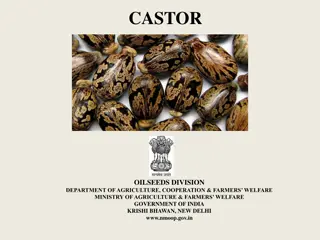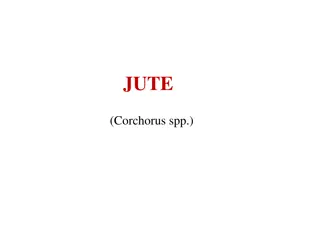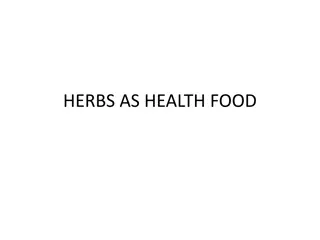Ginger Cultivation: A Comprehensive Guide for Farmers in India
Ginger cultivation in India is a prominent agricultural practice, with the country being a leading producer of this herb. Learn about the climate, soil requirements, varieties, planting season, and land preparation techniques for successful ginger farming. Discover the best practices for cultivating ginger and maximizing yield in this informative guide.
Download Presentation

Please find below an Image/Link to download the presentation.
The content on the website is provided AS IS for your information and personal use only. It may not be sold, licensed, or shared on other websites without obtaining consent from the author. Download presentation by click this link. If you encounter any issues during the download, it is possible that the publisher has removed the file from their server.
E N D
Presentation Transcript
GINGER CULTIVATION Submitted by Sudha rani Id no. -13154
(Zingiber officinale Rosc.) (Family: Zingiberaceae GINGER herbaceous perennial, the rhizomes of which are used as a spice. India is a leading producer of ginger in the world and during 2012-13 the country produced 7.45 lakh tonnes of the spice from an area of 157839 hectares. Ginger is cultivated in most of the states in India. However, states namely Karnataka, Orissa, Assam, Meghalaya, Arunachal Pradesh and Gujarat together contribute 65 per cent to the country s total production
Climate and soil Ginger grows well in warm and humid climate and is cultivated from sea level to an altitude of 1500 m above sea level. Ginger can be grown both under rain fed and irrigated conditions. For successful cultivation of the crop, a moderate rainfall at sowing time till the rhizomes sprout, fairly heavy and well distributed showers during the growing period and dry weather for about a month before harvesting are necessary. Ginger thrives best in well drained soils like sandy loam, clay loam, red loam or lateritic loam. A friable loam with a pH of 6.0 to 6.5 rich in humus is ideal. However, being an exhausting crop it is not desirable to grow ginger in the same soil year after year. The crop performs well in a temperature range of 19 C- 28 C and a humidity of 70-90%.
Varieties Several cultivars of ginger are grown in different ginger growing areas in India and they are generally named after the localities where they are grown. Some of the prominent indigenous cultivars are Maran, Kuruppampadi, Ernad, Wayanad, Himachal and Nadia. The exotic cultivar Rio-de-Janeiro have also become very popular among cultivators. The improved varieties of ginger arevariety Varada is suited for fresh ginger, dry ginger and making candy while, IISR Rejatha is rich in essential oil.
Season The best time for planting ginger in the West Coast of India is during the first fortnight of May with the receipt of pre-monsoon showers. Under irrigated conditions, it can be planted well in advance during the middle of February or early March. Early planting with the receipt of summer showers during February-March results in higher yield and reduces disease incidence. Land preparation The land is to be ploughed 4 to 5 times or dug thoroughly with receipt of early summer showers to bring the soil to fine tilth. Beds of about 1 m width, 30 cm height and of convenient length are prepared with an inter- space of 50 cm in between beds. In the case of irrigated crop, ridges are formed 40 cm apart. In areas prone to rhizome rot disease and nematode infestations, solarization of beds for 40 days using transparent polythene sheets is recommended.
Planting Ginger is propagated by portions of rhizomes known as seed rhizomes. Carefully preserved seed rhizomes are cut into small pieces of 2.5-5.0 cm length weighing 20-25 g each having one or two good buds. The seed rate varies from region to region and with the method of cultivation adopted. At higher altitudes the seed rate may vary from 2000 to 2500 kg/ha. The seed rhizomes are treated with mancozeb . planted at a spacing of 20-25 cm along the rows and 20-25 cm between the rows. The seed rhizome bits are placed in shallow pits prepared with a hand hoe and covered with well decomposed farm yard manure and a thin layer of soil and leveled.
Irrigation Ginger is cultivated as rainfed crop in high rainfall areas (uniform distribution for 5 to 7 months) and irrigated crop in less rainfall areas where distribution is not uniform. Ginger requires 1300-1500 mm of water during its crop cycle. The critical stages for irrigation are during germination, rhizome initiation (90 DAP) and rhizome development stages (135 DAP). Sprinklers and drip system can also be employed for better water use efficiency and enhanced yield.
Inter cropping and crop rotation Crop rotation is generally followed in ginger. The crops most commonly rotated with ginger are tapioca, ragi, paddy, gingelly, maize and vegetables. In Karnataka, ginger is also mix cropped with ragi, red gram and castor. Ginger is also grown as an intercrop in coconut, arecanut, coffee and orange plantations in Kerala and Karnataka. However, crop rotation using tomato, potato, chillies, brinjal and peanut should be avoided, as these plants are hosts for the wilt causing organism, Ralstonia solanacearum.
Plant protection Diseases Soft rot Soft rot is the most destructive disease of ginger which results in total loss of affected clumps. The disease is soil-borne and is caused by Pythium spp. among which, P. aphanidermatum and P. myriotylum are widely distributed in the country. The fungus multiplies with build up of soil moisture with the onset of south west monsoon. Younger sprouts are most susceptible to the pathogen. The infection starts at the collar region of the pseudostem and progresses upwards as well as downwards. The collar region of the affected pseudostem becomes water-soaked and the rotting spreads to the rhizome resulting in soft rot with characteristic foul smell.
Bacterial wilt Bacterial wilt caused by Ralstonia solanacearum Water soaked spots appear at the collar region of the pseudostem and progresses upwards and downwards. The first conspicuous symptom is mild drooping and curling of leaf margins of the lower leaves which spread upwards. Leaf spot Leaf spot is caused by Phyllosticta zingiberi. The disease starts as water soaked spot and later turns as a white spot surrounded by dark brown margins and yellow halo. The lesions enlarge and adjacent lesions coalesce to form necrotic areas. The disease spreads through rain splashes during intermittent showers.
Nematode pests Root knot (Meloidogyne spp.), burrowing (Radopholus similis) and lesion (Pratylenchus spp.) nematodes are important nematode pests of ginger. Stunting, chlorosis, poor tillering and necrosis of leaves are the common aerial symptoms. Characteristic root galls and lesions that lead to rotting are generally seen . in roots. The infested rhizomes have brown, water soaked areas in the outer tissues. Nematode infestation aggravates rhizome rot disease.
Insect pests Shoot borer The shoot borer (Conogethes punctiferalis) is the most serious insect pest of ginger. The larvae bore into pseudostems and feed on internal tissues resulting in yellowing and drying of leaves of infested pseudostems. The presence of a bore-hole on the pseudostem through which frass is extruded and the withered and yellow central shoot is a characteristic symptom of pest infestation The adult is a medium sized moth with a wingspan of about 20 mm; the wings are orange-yellow with minute black spots. Fully-grown larvae are light brown with sparse hairs. The pest population is higher in the field during September-October.
Rhizome scale The rhizome scale (Aspidiella hartii) infests rhizomes in the field (at later stages) and in storage. Adult (female) scales are circular (about 1 mm diameter) and light brown to grey and appear as encrustations on the rhizomes. They feed on sap and when the rhizomes are severely infested, they become shriveled and desiccated affecting its germination. Minor pests Larvae of leaf roller (Udaspes folus) cut and fold leaves and feed from within, and are generally seen during the monsoon season. Root grubs (Holotrichia spp.) occasionally feed on tender rhizomes, roots and base of pseudostems causing yellowing and wilting of shoots
Management practices For organic production, traditional varieties adapted to the local soil and climatic conditions that are resistant or tolerant to diseases, pests and nematode infection should be used. All crop residues and farm wastes like green loppings, crop residues, grasses, cow dung slurry poultry droppings etc. available on the farm can be recycled through composting, including vermicomposting so that soil fertility is maintained at high level.
Harvesting Ginger attains full maturity in 210-240 days after planting. Harvesting of ginger for vegetable purpose starts after 180 days based on the demand. However, for making dry ginger, the matured rhizomes are harvested at full maturity i.e. when the leaves turn yellow and start drying Processing of ginger Processing of ginger to produce dry ginger basically involves two stages- peeling of the ginger rhizomes to remove the outer skin and sun drying to a safe moisture level. The peeled rhizomes are washed before drying. The dry ginger so obtained is valued for its aroma, flavour and pungency.
Drying The moisture content of fresh ginger at harvest is about 80-82% which is brought down up to 10% for its safe storage. Generally ginger is sun dried in a single layer in open yard which takes about 8 to 10 days for complete drying. Polishing, cleaning and grading Polishing of dried ginger is done to remove the dry skin and the wrinkles developed on the surface during drying process. It is generally done by rubbing against hard surface. Cleaning of dry ginger is done manually to remove the extraneous matter and the light pieces. Once the ginger is cleaned and it is graded manually based on size of the rhizome, its colour, shape and the extent of residual lime (in the case of bleached ginger).
Storage Dry ginger, packaged in gunny bags are highly susceptible to infestation by insects like Lasioderma serricone (cigarette beetle) during storage. Fully dried rhizomes can be stored in airtight containers such as high density polyethylene or similar packaging materials. Long term storage for more than two years would result in deterioration of its aroma, flavour and pungency
